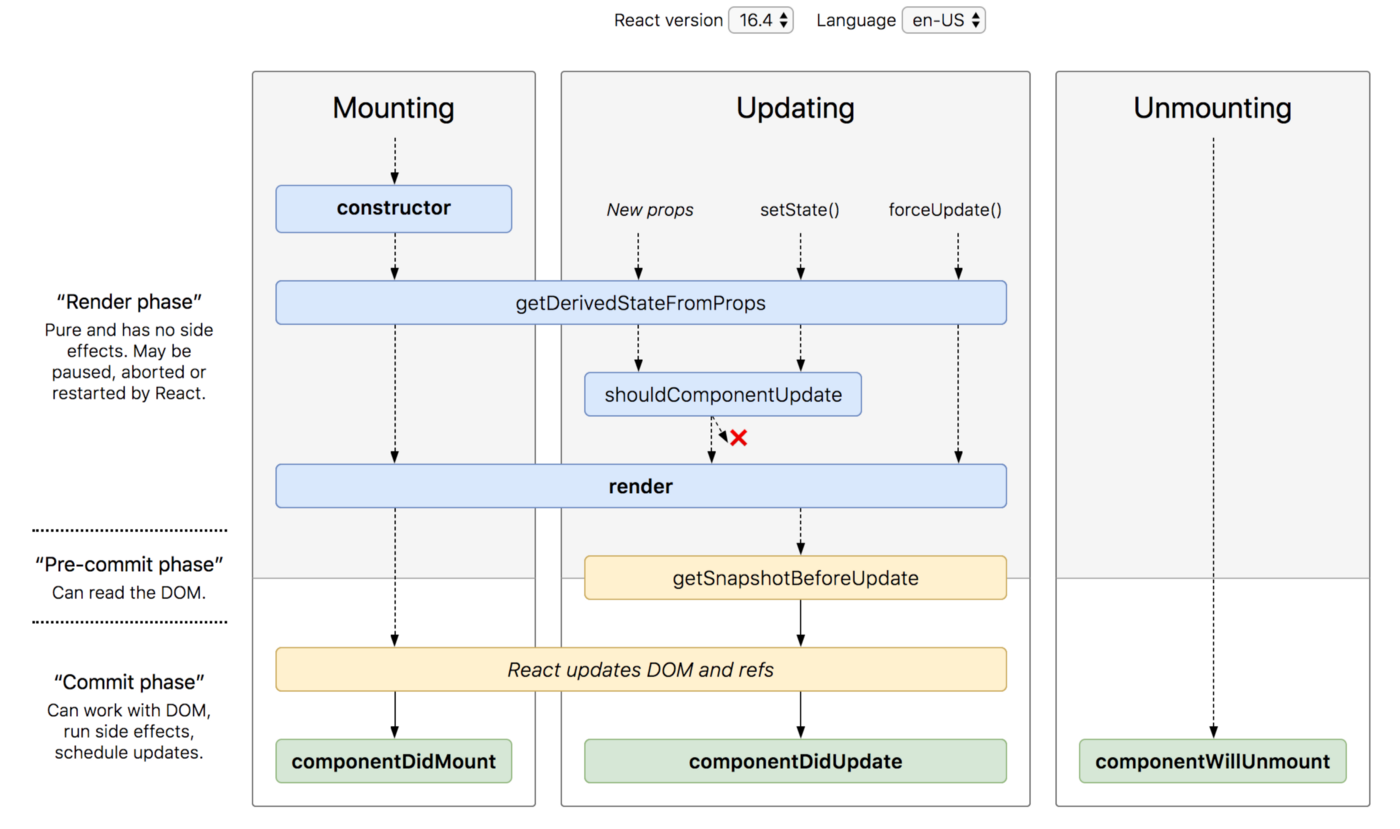
# 首次生命周期函数调用顺序如下
constructor- 初始化,组件状态
- 唯一可以直接修改 state 的地方
getDerivedStateFromProps用来替换componentWillReceiveProps- 用外部的属性来初始化内部的状态
- 当 state 需要从 props 初始化时使用
- 每次(父组件也会引起子组件) render 都会调用
- 无论父组件传递的props是否发生变化都会经过 componentWillReceiveProps 函数
- 使用不当,易产生 bug
~~componentWillMount/UNSAVE_componentWillMount~~+render之前调用,在此声明周期中使用setState不会触发额外渲染,因为你不可能在创建期实现把数据渲染出来。只能在componentDidMount中使用setState把数据塞回去,通过更新界面来展示数据。render- 必须定义,UI 渲染
componentDidMount(第一次render之后执行)- 获取外部资源,只执行一次。
# 当组件的 props 或 state 发生变化时会触发更新。组件更新的生命周期调用顺序如下:
static getDerivedStateFromProps()shouldComponentUpdate()- 用户可以介入,性能优化的过程。组件是否更新。
- 一般由 PureComponent 自动实现
render()getSnapshotBeforeUpdate()用来替换componentWillUpdate- 页面更新前调用,
state已更新 - 可用来获取
render前最新的DOM数据
- 页面更新前调用,
componentDidUpdate()- 每次更新都会调用
# 卸载 当组件从 DOM中移除时会调用如下方法:
componentWillUnmount()
# 有哪些⽣命周期被舍弃(3个),哪些⽣命周期是新增(2个)?
- 舍弃
~~componentWillMount~~~~componentWillReceivePorps~~~~componentWillUpdate~~
- 新增
getDerivedStateFromProps(可以用来替换componentWillReceiveProps())- 根据
props更新state上的meuns
// 这个方法已经不建议使用 componentWillReceiveProps(next){ this.setState({ menus:next.role.menus }) }- 替代方法
static getDerivedStateFromProps(nextProps, prevState){ if (nextProps.role.menus !== prevState.menus) { // 额外写一个newMeuns state来记录上一个props,在组件渲染的时候传入这个更新后的newMeuns return { newMenus:nextProps.role.menus }; } // 不更新state return null }getSnapshotBeforeUpdate()(在最近一次渲染输出(提交到DOM节点)之前,render之后调用)
# 这些⽣命周期被舍弃或新增的原因?以及新增⽣命周期的参数和作⽤?
- 会导致组件不必要的更新,父组件渲染即使没有改变
props也会调用componentWillReceivePorps - 异步渲染时间长会导致
componentWillUpdate、componentDidUpdate之间的时间变长,这个过程中可能发生一些变化,比如用户行为导致 DOM 发生了新的变化,这时在componentWillUpdate获取的信息可能就不可靠了 - 作用
static getDerivedStateFromProps(nextProps, prevState)接收两个参数(它内部你只能访问到组件上的这两个参数),第一个为接收到的新参数,第二是是当前的state。会返回一个对象用来更新state不需要可以返回null
class Hehe extends React.Component {
state={
isRight:false,
xxx:xxx
}
static getDerivedStateFromProps(nextProps, prevState){
if(nextProps.xxx===prevState.xxx){
return {
isRight:true
}
}
return null
}
}
# React⼏个版本(1.6.3、1.6.4、1.7.0)对⽣命周期的相关处理和规划?
- 1.6.3 新旧可以混用。
- 1.6.4 使用旧生命周期,开发者模式下会有警号
- 1.7.0 移除旧的生命周期
# 为什么要把getDerivedStateFromProps设计为静态⽅法?
- 内部不能拿到
this,比较纯粹,不能用setState(),会在render方法之前被调用
# getDerivedStateFromProps被触发执⾏的条件有哪些?
- 组件挂载的时候
- 接收到新的
props时 - 组件卸载时
- 父组件更新
- 内部组件执行了
state可以总结为一句话,此静态方法会在render之前被调用,在初始挂载以及后续更新的时候都会被调用。
# Derived state的定义是?(如何理解derived state?)
派生一个state,根据传入的props进行state的更新
# 1.6.2及其以前升级到1.6.4的⽅案是?
虽然废弃了这三个生命周期方法,但是为了向下兼容,将会做渐进式调整。 V16.3 并未删除这三个生命周期,同时还为它们新增以 UNSAFE_ 前缀为别名的三个函数 UNSAFE_componentWillMount()、UNSAFE_componentWillReceiveProps()、UNSAFE_componentWillUpdate()。 在 16.4 版本给出警告将会弃用 componentWillMount()、componentWillReceiveProps()、componentWillUpdate() 三个函数
# 1.6.x升级到1.7的⽅案是?
- 在 17 版本将会删除 componentWillMount()、componentWillReceiveProps()、componentWillUpdate() 这三个函数,会保留使用 UNSAFE_componentWillMount()、UNSAFE_componentWillReceiveProps()、UNSAFE_componentWillUpdate()
- 使用 react-lifecycles-compat polyfill
# 生命周期的三个阶段
- 创建期
- 存活期
- 清理期
# 创建期
import Com from './my-component'
export default class ParentComponent extends React.Component {
render() {
return (
<div>
<Com />
</div>
)
}
}
父组件的 render 方法执行的时候会实例化子组件 <Com/> ,当真正的 DOM 渲染之后,子组件的componentDidMount 函数会比父组件的更早执行。
# 存活期
创建期过去之后,创建期函数不会再被调用。componentDidMount 函数是在 DOM 被渲染出来之后执行的,componentDidMount 中的某些操作将常驻内存,比如绑定了事件,还有一些操作可以带来界面的更新,即在 componentDidMount 中调用 this.setState 。
进入存活期就存在组件更新的情况,组件有三中更新的方式:
- 自己调用
this.setState() - 自己调用
this.forceUpdate() - 父组件更新
- 父组件调用
this.setState或this.forceUpdate或祖组件更新带来的props更改)时导致自己的props被更改。
- 父组件调用
# 存活期组件更新的要点
setState是异步的- 父组件异步加载数据